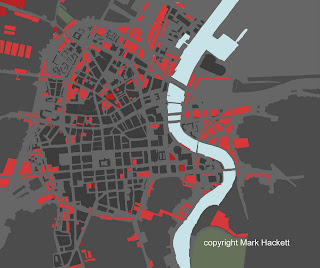
Last Thursday saw several hundred people scoff the available nibbles and pack into the crowded Reception Hall upstairs in the newly refurbished City Hall. Architects, planners, community workers, ratepayers, and even the odd Flip camera-wielding blogger gathered to listen to the launch of the Forum for Alternative Belfast’s analysis of the city’s potential.
You might remember news stories during the summer about a group of architects and planners getting together for a week long summer school to draw up a map of Belfast’s empty land. The participants found that around 32,000 people live within a 15 minute walk from the city centre with 73% of them living in rented accommodation.
But conservative estimates suggested that the 265 football pitches worth of vacant land could support at least additional 50,000 people in the central city, without resorting to high-rise buildings or creating a concrete jungle with no green spaces.
The video highlights some of what was conveyed during the launch meeting that was kicked off by Belfast’s Lord Mayor Naomi Long, featured input from Ken Sterrett and Mark Hackett, before being wrapped up by Belfast City Council Chief Executive Paul McNaney.
There was a lot to take in and think about.
Over the last 35-50 years, people have been moving out of living in the centre of Belfast. Yet the city centre population doubles each week day as commuters travel in to work. The Council’s Chief Executive was quick to point out that bringing more people back to live in the city would boost the rates the council can collect to subsidise the daytime migrants.
Those speaking steered clear of demonising cars. But they insisted that they should be managed and used for good. Free up land wasted on flat car parks – one example was at the recent Gas Works development off the Ormeau Road – and instead allow cars to park along the side of the road. Stationary cars can protect pedestrians from the noise and the danger of busy roads.
Waste ground together with expanses of ground level parking can host criminal activity and certainly make passers by feel fearful.
The Forum criticised some of the buildings that have been erected over the past 35 years. In particular, some social housing schemes were singled out as poor use of public money that created dysfunctional spaces. Yet Mark Hackett was willing to admit that the very architects and planners who were backing the Forum for Alternative Belfast were guilty too.
The Forum is independent of statutory bodies. It’s a set of expert but outside voices pitching in ideas to the public square on the potential that Belfast could realise if it grasps the “fill up” strategy.
Of course, while bringing 50,000 people back to live in the city centre could make a massive difference to Belfast, it would also have an effect on the outlying commuter towns (and city). It could partially relieve the housing pressure in Bangor, Holywood, Lisburn, Dromore, Banbridge. Yet it would cement Belfast’s commercial dominance and cast an even darker shadow over it’s smaller provincial rivals.
Good for Belfast? Not so good for everywhere else?
Whatever the answer – and no doubt you’ll let me know what you think in the comments – the Forum for Alternative Belfast has built up an impressive head of steam with its credible arguments for changing the planning assumptions and public perceptions. Good luck to them.
2 comments:
It is very thought provoking isn't it...i'm always surprised by the things the guys come out with. Glad you enjoyed the event - i didn't get, but will be at the next one. Chris, Weber Shandwick.
It is clear that the present city of Belfast is a relatively unfriendly place that doesn't work so well, subject as it is to daily tidal flows of commuters and filling-up with parked cars: it should have a larger resident population. To 'turn around' the existing situation, however, is going to be a substantial job, especially to (probably) reverse the existing statutory plans but I think that a start should be made, as soon as possible!
Post a Comment